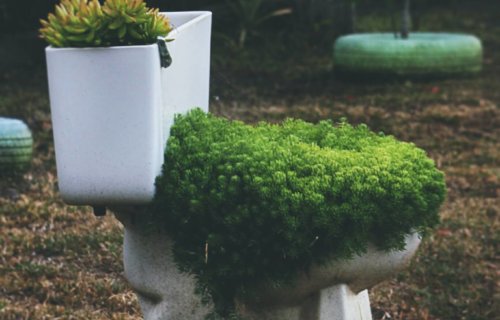STUTTGART, Germany — Fertilizers containing human waste could combat global warming, according to new research. An international team says recycling someone’s waste is safe, effective, and provides an excellent alternative to chemicals which can pollute the environment.
German researchers suggest that our toilets may become “manufacturing plants” for the agricultural industry in the future. Producing traditional fertilizers is energy intensive, resulting in significant carbon dioxide (CO2) emissions.
“Here we show that products derived from recycling human urine and feces are viable and safe nitrogen fertilizers for cabbage cultivation. The fertilizers from nitrified human urine gave similar yields as a conventional fertilizer product, and did not show any risk regarding transmission of pathogens or pharmaceuticals,” says first author Franziska Häfner, a PhD student at University of Hohenheim, in a media release.
“The combined application of nitrified urine fertilizers and fecal compost led to slightly lower crop yields, but may increase soil carbon content in the long term, promoting climate-resilient food production.”
Greener fertilizers would also bring down prices
Prices soared over 300 percent last year because of the war in the Ukraine. Hafner and the team compared the marketable crop yield of white cabbage grown between June and October 2019 at the Leibniz Institute of Vegetable and Ornamental Crops. Plots were filled with sandy, loamy, or silty soil enriched with four recycled fertilizers, applied gradually over the growing season.
The benchmark was commercially available organic vinasse, produced through the fermentation of biomass residues from bioethanol production. Researchers also tested two “nitrified urine fertilizers” (NUFs) synthesized from human urine, collected separately from feces. Nitrogen-bearing compounds are converted by microbes into valuable ammonium and nitrate.
The first was Aurin, recently approved for use in human agriculture in Switzerland, Liechtenstein, and Austria. The other was CROP (combined regenerative organic food production), developed by the Institute of Aerospace Medicine of the German Aerospace Center to recycle wastewater on Moon or Mars bases.
Effects of the NUFs on cabbage growth were tested both when applied separately to the soil, or in combination with fecal compost, recycled from dry toilets. The marketable yield, defined as the parts of the cabbages that can be sold, ranged from 35 to 72 metric tons per hectare.
This yield was highest for plots fertilized by Aurin, CROP, or vinasse. Best results were on sand, followed by silt and loam. The results indicate that soils fertilized with NUFs are as productive as those supplied with widely used commercial vinasse.
Human waste compost had significantly fewer chemicals in it
Screening for the presence of 310 chemicals in the fecal compost found only 6.5 percent of these substances were present above the limit of detection in the compost. Only the painkiller ibuprofen and the anticonvulsant and mood-stabilizing drug carbamazepine were detectable in the edible parts of the cabbages — at markedly low concentrations. More than half a million cabbage heads would need to be eaten to accumulate a dose equivalent to one carbamazepine pill.
“In general, the risk for human health of pharmaceutical compounds entering the food system by means of fecal compost use, seems low,” the study authors say.
Around the world, prices of fertilizers have been breaking records over the past year, amidst extreme weather, transport disruptions, and now the Russian invasion of Ukraine. Russia, which is contending with Western sanctions, produces large quantities of key chemicals used in the production of fertilizers. They also supply much of the natural gas used to produce ammonia — a major component of nitrogen fertilizers.
Soaring prices are causing farmers to adjust their planting strategies. They’re also driving interest in alternatives to conventional products.
“Our study results demonstrate that nitrified urine fertilizers such as Aurin and CROP have a huge potential as fertilizer in agriculture. They argue for a greater use of these recycled products in the future,” adds lead author Dr. Ariane Krause, a scientist at the Leibniz Institute of Vegetable and Ornamental Crops.
“If correctly prepared and quality-controlled, up to 25% of conventional synthetic mineral fertilizers in Germany could be replaced by recycling fertilizers from human urine and feces. Combined with an agricultural transition involving the reduction of livestock farming and plant cultivation for fodder, even less synthetic fertilizer would be necessary, resulting for example in lower consumption of fossil natural gas.”
The study is published in the journal Frontiers in Environmental Science.
South West News Service writer Mark Waghorn contributed to this report.

China has used human waste for centuries, in North Korea there’s a quota to be met. To really make an impact in CO2 we need to outlaw carbonated beverages worldwide. Bwahahahaha….
It is utterly ridiculous to discuss “green fertilizer” as not having “chemicals” and think that makes human waste a good source of soil nutrients. Pure human waste is fine, provided the source is healthy and not taking pharmaceutical drugs. However, how do you propose we collect this miracle fertilizer? You can’t collect it in the form of biosolids which are processed sewage because of all the chemicals that make their way into the process. This is silly. BTW, CO2 is a primary plant nutrient, which is the same thing that fertilizer is.
Best of Agriculture 4.0 – Farmers are already reducing fertilizer cost and use over 70% and reducing soil toxicity with the “SNX30 fertilizer supplement”. It’s backed by a growing number of agronomists and NCGA Corn Yield Winners too.
There is a USA product called milorganite made from Milwaukee sewage. Great for lawns golf courses love it as it goes not burn the grass. We have 100’s of cities that can do this also for grass and crops